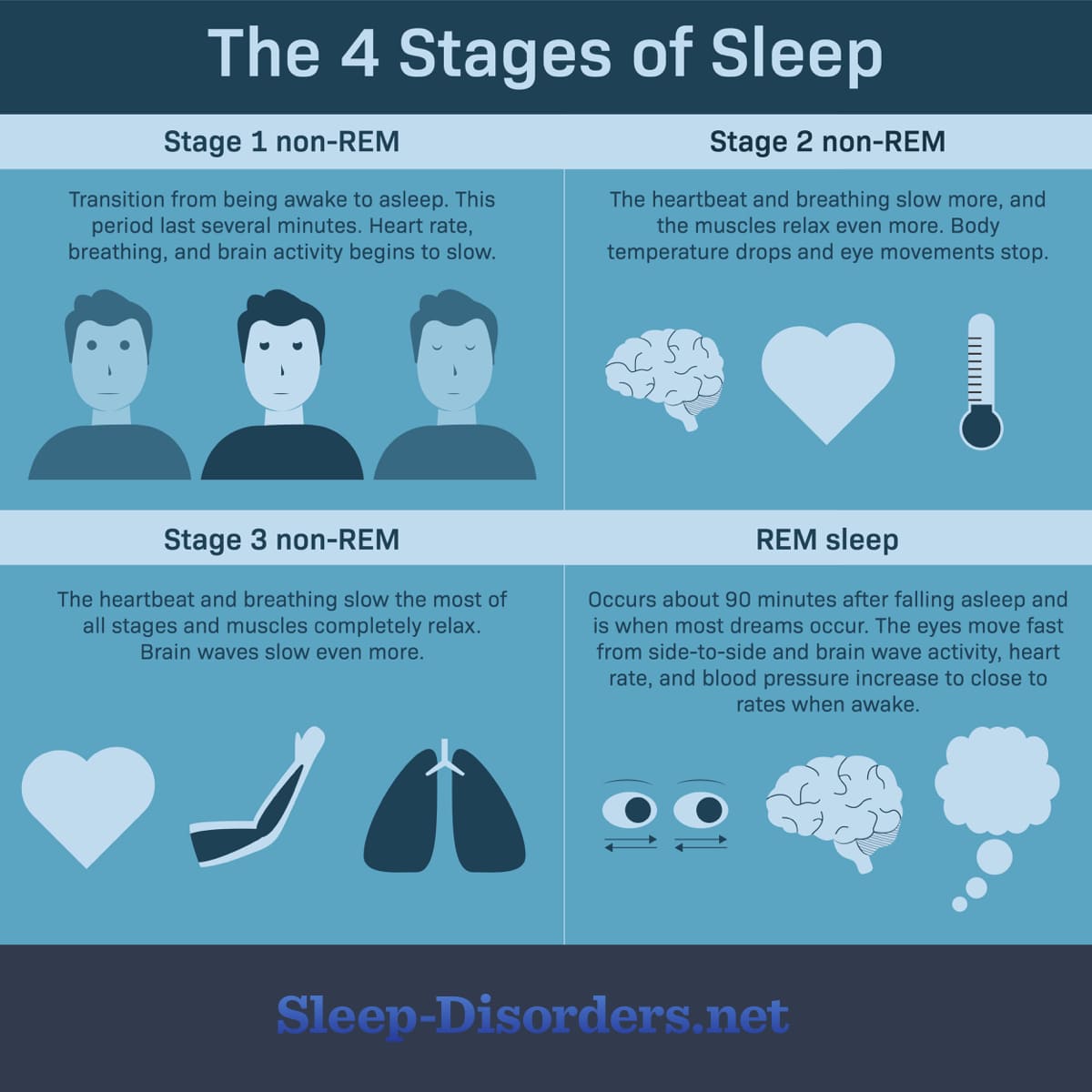The 4 Stages of Sleep
Reviewed by: HU Medical Review Board | Last reviewed: June 2020 | Last updated: January 2021
Good quality sleep that leaves you feeling rested and energetic is vital to overall health. “Good quality” means getting enough restful sleep at the right times. Though doctors do not fully understand sleep, they do know it impacts:
- How the brain works
- How the body repairs and restores itself
Without enough sleep, a person has trouble learning, concentrating, and forming new memories. Physically, sleep affects the entire body, including the immune system, heart rate, blood pressure, metabolism, energy levels, hunger, and mood.1-3
Types of sleep
Adults spend about one-third of their day sleeping, or 7 to 9 hours. There are 2 types of sleep:
- Rapid-eye movement (REM), when most dreams occur
- Non-REM, which has 3 stages, including the deepest sleep
During normal sleep, a person cycles through REM and non-REM stages several times during the night. Each cycle lasts about 90 minutes, but the amount of non-REM versus REM sleep changes throughout the night. More REM sleep tends to occur toward the morning.
Sleep disorders disrupt these normal cycles which in turn causes other health problems. Both REM and non-REM sleep are needed to stay healthy.1,4
The 4 stages of sleep
The 4 stages of a normal sleep cycle are each tied to certain brain waves and brain activity.
Stage 1 (or N1)
Stage 1 non-REM (or N1) sleep is the change from being awake to asleep. This period lasts several minutes while the heartbeat, breathing, eye movements, and brain waves slow. The muscles relax, sometimes with a twitch. This is the lightest stage of sleep.
Stage 2 (or N2)
Stage 2 non-REM (or N2) sleep is the stage between very light N1 sleep and the deep sleep of N3. The heartbeat and breathing slow more, and the muscles relax even more. Body temperature drops and eye movements stop. The brain waves slow too, but with short bursts of electrical activity. The body spends more time in stage 2 during the night than other sleep stages.
Stage 3 (or N3)
Stage 3 non-REM (or N3) sleep is often called deep sleep. The heartbeat and breathing slow the most of any sleep stage, and the muscles completely relax. Brain waves slow even more. It may be hard to wake up a person in stage 3 sleep. The body stays in stage 3 for the longest time during the first half of the night and is necessary to feel refreshed in the morning.
Stage 4 REM sleep
Stage 4 REM sleep first occurs about 90 minutes after falling asleep and accounts for less than one-fourth of total sleep time. Most dreams occur during REM sleep. The eyes move fast from side-to-side under the eyelids. Brain wave activity, heart rate, and blood pressure increase to close to rates when awake. Breathing becomes faster and inconsistent. Arm and leg muscles become temporarily paralyzed so you cannot act out your dreams. Older people spend less time in the REM stage.1,2
Figure 1. Stages of sleep
How the body controls the stages of sleep
Two bodily processes work together to control when you wake and sleep: circadian rhythms and homeostasis.1
Circadian rhythms, or biological clock, control a range of body functions, including sleep, waking, hunger. These rhythms are tied to the earth’s 24-hour day so that a body responds to morning light by waking up and evening darkness by getting sleepy.
Homeostasis, or sleep drive, is a body process that helps track the need for sleep. The longer a person is awake, the stronger the drive becomes to sleep. This drive causes a person to sleep longer and more deeply after a period of too little sleep.
Many things can disrupt the body’s circadian rhythms and homeostasis, and cause sleep problems, including:
- Shift work
- Pregnancy or menopause
- Stress
- Drugs (prescription, over-the-counter, or illegal)
- Alcohol
- Jet lag
- Sleep environment
- Health conditions such as Parkinson’s disease or autoimmune disorders
